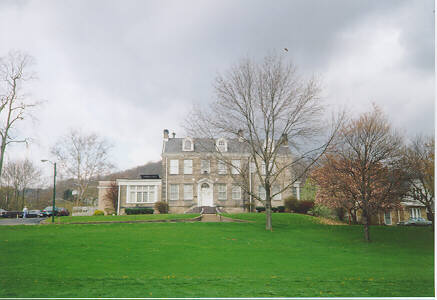Monument Place
 Monument Place, originally Shepherd Hall, was built in 1798 as a residence on the grounds of the Shepherd plantation. Early Wheeling settlers and hosts to many famous people, Col. Moses & Lydia Boggs Shepherd used the influence of their friend, U.S. Senator Henry Clay, to ensure that the new National Road would pass directly by their residence. Construction on the road began in Maryland in 1811, and as the road made its way east through Pennsylvania and into Virginia territory, it followed the valley of Wheeling Creek, passing Roney’s Point, Triadelphia, and Shepherd Hall in Elm Grove before arriving in the sleepy little river town of Wheeling in 1818. The strategic positioning of the National Road intersecting the Ohio River at Wheeling provided the impetus for Wheeling to develop into a major inland port for freight and passengers moving between the east and west. In gratitude for his support in bringing the National Road to Wheeling, Lydia and Moses, in 1820, erected a monument dedicated to Henry Clay on their property near the National Road. Thus, Shepherd Hall eventually came to be known as Monument Place. Though the monument no longer stands, the residence, now the Osiris Shrine Center, stands strong and is a testament to the prosperity and growth the National Road brought to Wheeling.
Monument Place, originally Shepherd Hall, was built in 1798 as a residence on the grounds of the Shepherd plantation. Early Wheeling settlers and hosts to many famous people, Col. Moses & Lydia Boggs Shepherd used the influence of their friend, U.S. Senator Henry Clay, to ensure that the new National Road would pass directly by their residence. Construction on the road began in Maryland in 1811, and as the road made its way east through Pennsylvania and into Virginia territory, it followed the valley of Wheeling Creek, passing Roney’s Point, Triadelphia, and Shepherd Hall in Elm Grove before arriving in the sleepy little river town of Wheeling in 1818. The strategic positioning of the National Road intersecting the Ohio River at Wheeling provided the impetus for Wheeling to develop into a major inland port for freight and passengers moving between the east and west. In gratitude for his support in bringing the National Road to Wheeling, Lydia and Moses, in 1820, erected a monument dedicated to Henry Clay on their property near the National Road. Thus, Shepherd Hall eventually came to be known as Monument Place. Though the monument no longer stands, the residence, now the Osiris Shrine Center, stands strong and is a testament to the prosperity and growth the National Road brought to Wheeling.
▶ History of Monument Place in Elm Grove, WV, 1925
Also see: Biography—Lydia Boggs Shepherd Cruger
Location
▶ 91 Kruger St.
Images

Additional Resources
Materials in the Library:
▶ Time Steals Softly, Harper, Virginia Jones, 1974 (Historical Fiction) Call #: Fic Harp 1974
Materials in the Wheeling Room: (non-circulating, ask for access at the reference desk)
Materials in the Library Archives & Special Collections: (non-circulating - access by appointment only, call 304-232-0244.)

